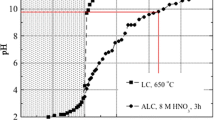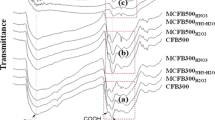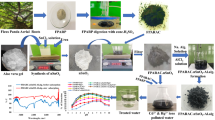Abstract
The adsorption efficiency of Opuntia ficus indica fibres regarding the removal of hexavalent uranium [U(VI)] from aqueous solutions has been investigated prior and after the chemical treatment (e.g. phosphorylation and MnO2-coating) of the biomass. The separation/removal efficiency has been studied as a function of pH, uranium concentration, adsorbent mass, ionic strength, temperature and contact time. Evaluation of the experimental data shows that biosorption is strongly pH-depended and that the MnO2-coated product presents the highest adsorption capacity followed by the phosphorylated and non-treated material. Experiments with varying ionic strength/salinity don’t show any significant effect on the adsorption efficiency, indicating the formation of inner-sphere surface complexes. The adsorption reactions are in all cases exothermic and relatively fast, particularly regarding the adsorption on the MnO2-coated product. The results of the present study indicate that adsorption of uranium from waters is very effective by cactus fibres and particularly the modified treated fibres. The increased adsorption efficiency of the cactus fibres is attributed to their primary and secondary fibrillar structure, which result in a relative relative high specific surface available for sorption.









Similar content being viewed by others
References
Choppin GR (2007) Actinide speciation in the environment. J Radioanal Nucl Chem 273:695–703
Burkart W, Danesi PR, Hendry JH (2005) Properties, use and health effects of depleted uranium. Int Congr Ser 1276:133–136
Nilanjana D (2012) Review remediation of radionuclide pollutants through biosorption—an overview. Clean Soil Air Water 40(1):16–23
Kanno M (1984) Present status of study on extraction of uranium from sea water. J Nucl Sci Technol 21:1–9
Tamada M (2009) Current status of technology for collection of uranium from seawater. Japan Atomic Energy Agency, Takasaki
Konstantinou M, Pashalidis I (2007) Adsorption of hexavalent uranium on biomass by-product. J Radioanal Nucl Chem 273:2095–2102
Prodromou M, Pashalidis I (2013) Radium removal from aqueous solutions by adsorption on non-treated and chemically modified biomass by-product. J Radioanal Nucl Chem 295:549–552
Barbera G, Carimi F, Inglese P (1992) Past and present role of the Indian-fig prickly-pear (Opuntia ficus-indica (L.) Miller, Cactaceae) in the agriculture of Sicily. Econ Bot 46:10–20
Shedbalkar UU, Adki VS, Jadhav JP, Bapat VA (2010) Opuntia and other cacti: applications and biotechnological insights. Trop Plant Biol 3:136–150
Barrera H, Urena-Nunez F, Bilyeu B, Barrera-Diaz C (2006) Removal of chromium and toxic ions present in mine drainage by Ectodermis of Opuntia. J Hazard Mater B136:846–853
EA Jenne (1998) Adsorption of metals by geomedia (variables, mechanisms and model applications). Academic Press, San Diego
Liao X, Lu Z, Du X, Liu X, Shi B (2004) Environ Sci Technol 38:324–328
Saleem N, Bhatti HN (2011) Adsorptive removal and recovery of U(VI) by citrus waste biomass. BioResources 6:2522–2538
Tatsuya O, Kanya K, Keisuke O, Katsutoshi I, Yoshinari B (2008) Preparation of phosphorylated bacterial cellulose as an adsorbent for metal ions. React Funct Polym 68:376–383
Varga Z (2007) Preparation and characterization of manganese dioxide impregnated resin for radionuclide preconcentration. Appl Radiat Isot 65:1095–1100
Khan MH, Warwick P, Evans N (2006) Spectrophotometric determination of uranium with arsenazo-III in perchloric acid. Chemosphere 63:1165–1169
Murthy PNP (2007) Identification of inositol phosphates by nuclear magnetic resonance spectroscopy: unravelling structural diversity. In: Turner BL, Richardson AE, Mullaney EJ (eds) Inositol phosphates: linking agriculture and the environment. CAB International, Oxfordshire
Xiang Q, Lee YY, Pettersson PO, Torget RW (2003) Heterogeneous aspects of acid hydrolysis of α-cellulose. Appl Biochem Biotechnol 105–108:505–514
Morgan JJ, Stumm W (1964) Colloid-chemical properties of manganese dioxide. J Colloid Sci 19:347–359
Baes CF, Mesmer RE (1976) The hydrolysis of cations. Wiley, New York
Ho YS (2004) Citation review of Lagergren kinetic rate equation on adsorption reaction. Scientometrics 59:171–177
Author information
Authors and Affiliations
Corresponding author
Rights and permissions
About this article
Cite this article
Prodromou, M., Pashalidis, I. Uranium adsorption by non-treated and chemically modified cactus fibres in aqueous solutions. J Radioanal Nucl Chem 298, 1587–1595 (2013). https://doi.org/10.1007/s10967-013-2565-0
Received:
Published:
Issue Date:
DOI: https://doi.org/10.1007/s10967-013-2565-0




